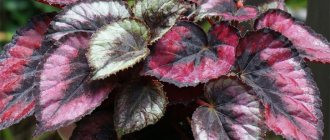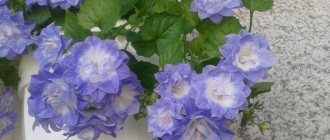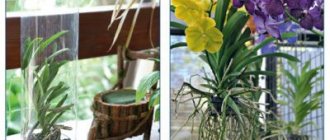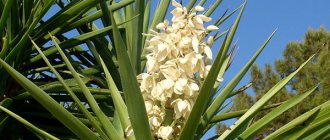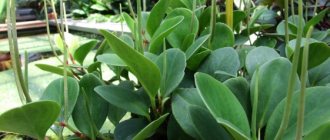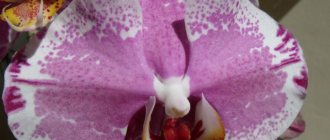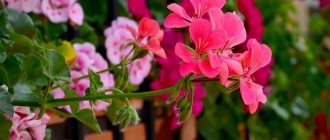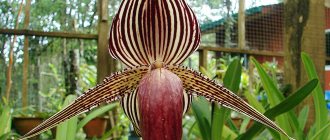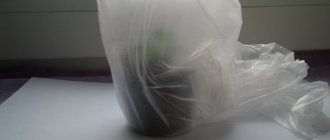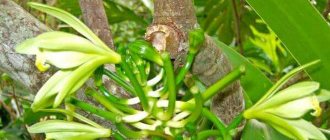The aroma of vanilla has been loved by many since childhood. Even after growing up, people often retain a particularly warm attitude towards him. Meanwhile, not everyone knows that the most delicious and fragrant spice is obtained from orchids. This amazing flower grows in equatorial countries. The cost of the spice is so high that they are trying to grow it in other regions. If you want to find out what else is special about the vanilla orchid, look at its photos and find out how to care for it, read our article and you’ll figure it all out.
Origin and history of the Vanilla orchid
An exotic flower is by definition an epiphyte. That is, it is able to take root on tree trunks (living or fallen) and stumps. Less common are orchids that live directly on the ground.
The name Vanilla (sometimes spelled incorrectly as “vanille”) is translated from Latin as “small pod.”
Now the plant is cultivated as an agricultural crop in countries with tropical climates. Half of the world's spice production comes from Madagascar.
In Europe, the plant was unknown for a long time. Only in the 16th century did they begin to import dry spice into the Old World. It was very expensive, and therefore botanists tried to adapt the flower to a more temperate climate.
Their success should be considered only partial. It was possible to grow orchids, but they did not produce precious pods. European botanists did not take into account an important detail. The crop needs pollination, and only one species of endemic bees, which lived exclusively in Mexico, did it.
Things got off the ground when a manual fertilization method was developed in the mid-19th century. The first scientific description comes from the pen of Henry Andrews, a British botanist. His work dates back to the beginning of the 19th century.
The Vanilla Orchid is being actively improved by breeders who have so far created more than 100 of its varieties. True, not all of them are suitable for growing at home.
WILD ORCHID
The Yucatan coast, in what is now Mexico, is where an expedition under the command of perhaps one of the most famous conquistadors in history, Hernán Cortés, landed in 1519. One of the first people Cortes met after he came ashore were representatives of the ancient Totonac people. The people whom Cortes met here were custodians of an exotic spice until that moment absolutely unknown to either Europeans or even Arab merchants, who had been supplying various spices to Europe for many centuries. It was something completely new and never seen before - vanilla.
0
The Totonacs grew and used vanilla for medicine, as incense in religious ceremonies, and as a way of reciprocity. By the way, the Totonacs paid tribute to the Aztecs, who captured this territory in the mid-15th century, in vanilla. Totonac settlements and cities were scattered along the entire coast and one of the largest was the city of Papantla, which still exists today. To this day, part of the inhabitants of this city are Totonacs, direct descendants of the Indians who were the first to meet the expedition of Hernan Cortez. Today, Papantla is the center of the Mexican vanilla industry. Not so long ago, the streets of Papantli were literally covered with vanilla. This is a still from a film from the 1920s, showing the streets of a city with a huge amount of vanilla left to dry in the sun.
0
The sweet aroma of vanilla that hung over the city made it famous throughout the world. For a long time, Papantla was known as the city that scented the whole world. Vanilla is still grown here today. This is what the vine of this plant looks like. Vanilla is an orchid, and for its growth it needs a so-called “guardian” - a tree that vanilla uses as a support. The fruits of the plant are pods, which are the source of such an expensive and beloved spice all over the world.
0
Vanilla is very demanding on weather and temperature conditions and sometimes you simply cannot do without the help of the gods. Every year a ritual takes place in Papantla - Danza de los Voladores (Dance of the Flyers). Five Totonacs rise to a height of thirty meters and perform an aerial dance. Once upon a time there was a severe drought here and it seemed that the entire vanilla crop on which the locals depend so much would die. The Totonacs thought for a long time about how to ask the gods to send them rain, and so this now famous fertility ritual was born.
0
The Spaniard Hernán Cortés was most likely one of the first Europeans to observe this ritual. But then he was interested in something more. The legends of Eldorado beckoned with its riches and, in search of gold, Cortez went deep into the territory to meet with the most powerful leader of the New World - Montezuma, king of the Aztecs. Montezuma greeted Cortez with a treat that is only suitable for kings - hot chocolate with vanilla. It is believed that Hernan Cortes was the very first European to taste this fabulous and unforgettable taste of the most aromatic spice.
0
Without wasting any time, he sent this exotic spice to his homeland in Spain. Of course, then without even suspecting that it was opening up a completely new taste for Europe. A taste that is perhaps the most popular and widespread in the world today.
Description of vanilla orchid, photo
In the wild, Vanilla is a very long vine. The length of individual specimens reaches 30 meters. Such a giant would not fit into any photograph.
The aerial roots, characteristic of the entire family of exotic flowers, are located along a flexible stem. They, among other things, provide reliable fastening of the plant to the tree.
At home, an orchid is usually kept in a flowerpot, and the shoots are supported by ladders, decorative arches, etc.
Vanilla leaves are fleshy, mostly colored emerald green. In some varieties they are variegated, that is, variegated. The latter are decorated with light green wide stripes.
The shape of the plates is oval, pointed, and quite dense. Peduncles are short racemose. They grow from the axils of almost all leaves. The older the orchid, the more shoots it produces and, accordingly, the more magnificent it looks.
Each peduncle in nature produces up to 10 medium-sized buds (diameter about 60 mm). In a house their number rarely reaches 5 pieces.
The vanilla orchid does not indulge in a wealth of shades - its flowers are always greenish-yellow. The lip is elongated, with a white edging. Elongated and petals.
Important: in order for the buds to appear, it is necessary to reproduce the conditions of the tropical forest at home as accurately as possible.
By and large, only two varieties are suitable for an apartment:
- Flat-leaved orchid (Latin - Vanilla planifolia);
- Lemon Splash.
The first one adapts perfectly to home conditions, but is distinguished by abundant flowering, lasting up to a month only in nature. The buds emit a strong, characteristic aroma. They bloom one by one.
The second variety has large elliptical leaves, fleshy and rich green. A distinctive feature is its very long aerial roots. Their healthy shade is gray, closer to white. Flowers the color of ripe lemon.
Selection and storage of spices
To choose a high-quality spice with a rich aroma, pay attention to some nuances:
- The stick is oily and plastic to the touch.
- Rich color from dark brown to black. There should be a bright, characteristic odor.
- Brittle, dry, cracked, light-colored sticks should not be taken. Most likely, due to improper storage they have lost their beneficial properties.
To ensure that the pods retain their pleasant aroma for a long time, keep the sticks in a dark, cool place in a hermetically sealed jar.
Famous brands of ground and bean vanilla:
- KOTANYI;
- Vanilla House;
- Holy Om;
- "Paprika-Cinnamon";
- "Spicy Symphony".
Natural vanilla powder can be replaced with vanillin (a synthetic analogue), vanilla sugar (sugar infused with vanilla aroma), vanilla extract or essence (vanilla tinctures of varying concentrations). It is better to buy goods in trusted places, large supermarkets, well-known online sites, i.e. where sellers can confirm the quality of the product.
Peculiarities
The vanilla orchid is primarily unique for its size. If phalaenopsis, more common in our area, rarely reaches 0.6-0.8 m (with peduncle), then the culture in question stretches up to 15 m.
Thanks to its great flexibility, the vine fits freely in any room, even a very modest one. Over time, of course, she will cover it all and turn it into a wonderful corner of tropical nature.
Every year the plant adds at least 50 cm, and in ideal conditions - even 100 cm. Another difference between the orchid is that it stores water directly in the stem, while other relatives accumulate liquid in the roots or leaves.
Description of the flower
An adult vanilla orchid plant is an extended vine attached to nearby trees up to 25 meters long.
- Adventitious aerial roots at the nodes of the stems, located along the entire length of the vine, allow the orchid to attach itself to plants and climb to the tops. The leaf blade is smooth, juicy, dense, narrow, up to 20 cm long.
- The leaves are arranged alternately.
- There are many flowers on the vine - up to 20 or more. They are light green, may have a yellow tint, and exude a sweet, attractive aroma. Flowers do not bloom immediately, but one by one, so on average flowering can last more than a month.
- The fruits are in the form of pods of yellow color with a green tint, concentrated in 5-10 pieces in a group. These pods are up to 25 cm long and are the source of the wonderful vanilla scent. They are used both in perfumery and in cooking. However, at least two vanilla orchid plants are needed for fertilization, so in temperate climates, houseplants practically do not bear fruit.
- But he can enjoy the abundance of flowers. In general, this vine blooms and produces fruits only after reaching maturity. This happens approximately 3 years after planting a young plant.
In another article we talked about another type of orchid - the Dracula orchid.
About flowering
The first buds appear on young orchids no earlier than three years later. This rule is equally relevant for both wild and cultivated specimens.
In the latter case, you often have to wait much longer for flowers. They open mainly in mid-spring or early summer.
The chances of harvesting your own vanilla crop are very slim. The fact is that it is not enough to achieve flowering; it is also necessary to pollinate correctly (by hand).
Regardless of the phase of its life cycle, an orchid needs a lot of heat and water. You will also have to constantly maintain high humidity.
In summer there is enough light for the flower, but in other seasons it is impossible to do without a phytolamp. The normal length of the day is at least 12 hours.
When flowering is completed, the crop enters a resting phase. At this time, it does not need abundant watering and large portions of fertilizers.
You shouldn’t really hope for the appearance of buds - in our area they are formed extremely rarely. However, the decorative value of an orchid lies primarily in its leaves and long, intricately curving shoots.
For flowering to begin, you will need:
- raise the humidity to about 85-90%;
- provide strong diffused lighting (this is difficult due to the length of the vine).
It will not be possible to stimulate the release of arrows using daily temperature fluctuations.
There is another, rather risky way. To do this, the flower is placed directly under the sun's rays. The problem is that it does not give a 100% guarantee, but the leaves will certainly suffer.
ONE DAY
Despite technological advances, vanilla cultivation today is essentially little different from what it was a thousand years ago. To this day, this process is very long, incredibly complex and labor-intensive. On average, it takes 3-4 years before vanilla can produce a crop of pods. Moreover, absolutely all vanilla that is grown outside of Mexico is produced through artificial pollination. Those. Every, literally every flower requires hand pollination. Add to this that the vanilla flower appears only once a year and blooms for only one day. Farmers only have half a day to carry out manual pollination because... The flower opens in the morning, and in the afternoon it closes and begins to fade.
0
Therefore, during the vanilla flowering period, every day, farmers check each plant for signs of open vanilla flowers and carry out pollination. If you miss flowering, consider your chance lost. But that's not all. Vanilla pods remain on the vine for another nine months before they can be harvested. At the same time, the vanilla harvest stretches over several months, because different pods ripen at different times. The farmer's ability to correctly identify pods that have reached the desired condition is a key factor in the quality of vanilla. The collected pods are then scalded with hot water, and then the long drying process begins. Every day, vanilla pods are taken out to dry in the sun, and in the evening, or in case of bad weather, they are collected and placed back in the boxes. And this continues every day for 4 to 6 months. Every morning the pods are laid out and every evening they are collected back.
0
On average, the entire process from pollination to the finished vanilla stick takes approximately 12 to 16 months. The last step will be the process of sorting and packaging the vanilla beans depending on their quality and size. Quality classifications may vary slightly from country to country, but to simplify things somewhat, the longer the vanilla pod, the more expensive it is. And it can be very high. If in 1995 a kilogram of vanilla cost about $50, then in 2004 the cost of vanilla soared to almost $550. And if now you look with some surprise at, say, your refrigerator, where there is vanilla ice cream, or at a plate with vanilla buns or candies, then I hasten to say that most of you, most likely, have never tasted real vanilla in your life .
Home care step by step
Despite the significant difference between the Vanilla orchid and other members of the family, its maintenance conditions are generally the same. Let's tell you about everything in more detail.
Where to put
The flower needs light and warmth. He can get all this by standing at a window oriented to the east or west. The northern direction is absolutely not suitable, and the southern direction remains the third acceptable alternative. However, here the orchid must certainly be protected from sunlight. A loose white curtain does the job well.
In summer, Vanilla can also be exhibited outside, but again in a shaded place.
Pot and soil
Choose a container for the plant that is wide, not cramped and not very deep. The material does not play a significant role. Both plastic and ceramic will do. The container should have holes in the bottom and on the walls - the roots need air.
Often the pots are hung or kept in flowerpots - this is how the climbing crop looks best.
Advice: be sure to install supports for the vine, since without them it often breaks under its own weight.
There are three criteria that the substrate must meet:
- high breathability;
- good moisture capacity;
- looseness.
Regular soil for the orchid discussed in this article will not work. It cannot be used in its pure form.
Add to its 2 parts:
- 3 – leaf soil;
- 1 – charcoal;
- 2 – perlite.
It is more advisable to use expanded clay as a drainage material.
Temperature
Regardless of the time of year, the Vanilla orchid requires warmth. The air in the room where it is kept should not cool to more than +20 °C. Moreover, it is desirable that the indicator be kept at +25 °C. In summer, the temperature will be +25 °C…+28 °C.
What the flower does not tolerate is sudden changes. The limit here is only 4 degrees. With more significant temperature fluctuations, he is highly likely to get sick.
Humidity
The plant reacts poorly to dry air - growth stops in such conditions. The optimal figure is 85%. Make sure it never drops too much. The general rule is that the hotter the room, the higher the humidity.
To regulate this parameter, it is necessary to use warm water sprays or showers.
Ventilate the room daily. Experienced flower growers often install a fan in the door of the room - it draws out stagnant air.
Lighting
Everything is simple here - the more, the better. Light should enter the room all day, and certainly diffused.
Avoid contact of foliage with the sun's rays, they burn. As a result, the plates quickly lose turgor, often wither and fall off.
If the flower is placed on a western window, then after lunch it should be shaded, regardless of whether it is summer or winter.
Watering
The Vanilla Orchid, the care of which we describe at home in this article, loves regular irrigation. Boiled or filtered water is suitable. Rain water is also allowed to be used, but provided that you collected it outside the city.
The temperature of the liquid cannot be lower than room temperature, but it is better if the indicator is +30 °C ... +32 °C.
Make sure that the soil in the pot is always left slightly moist. Give water strictly in the morning, as needed, just in the pot. Once a month, watering is done using the immersion method.
The order is as follows:
- Place the orchid in a tall container of suitable diameter.
- Carefully fill it with warm water to the ground level.
- Wait a quarter of an hour.
- Remove the flower and allow excess moisture to drain.
Important: Always remove any water that accumulates in the pot tray. It can cause root rot.
When the culture enters the dormant phase, all that remains is to ensure that the substrate never completely dries out. Add liquid in small portions, every other day.
Top dressing
During the active growing season, which falls in the spring-summer season, fertilizers are applied once a decade or twice a month. The intensity depends on the growth rate of the flower.
It is better to use ready-made complex formulations made specifically for orchids. Choose those where nitrogenous compounds predominate. With them, leaves and stems will be able to develop faster. Separate them more than the instructions recommend. In winter, the dosage is halved.
Apply fertilizers in the form of a solution, about half an hour after irrigation. Pour them over the edge of the pot.
Transfer
The orchid is moved to a new container and substrate every 2 or 3 years.
This procedure is required when:
- the roots no longer fit into the old container;
- the soil loses the necessary properties or turns sour;
- the flower gets sick.
The optimal time for transplantation is spring.
Choose a pot 2-4 cm larger than before. At the same time, it is advisable to carry out pruning.
The procedure is as follows:
- Sprinkle the substrate generously with warm water.
- Carefully remove the plant from the container.
- Wash the roots and inspect them, cut off any suspicious ones.
- Rub the wounds with charcoal powder.
- Treat the underground part with a fungicide and leave to dry.
- Place 2-3 cm of drainage material into the new pot.
- Set the orchid.
- Fill all voids with soil.
First steps after purchase
Vanilla is not affected by pests. When purchasing a plant, you should carefully inspect the stem. Dark spots are evidence of decay. It would be wiser to refuse to purchase such a copy.
During transportation, the Orchid must be protected from the scorching sun, wind, precipitation and cold. It is advisable to immediately replant a plant that arrives at a new home. The container needs to be shallow, with a large number of holes. In addition, it is important to arrange a drainage layer.
During transplantation, you must carefully handle the roots. Transplanted Vanilla is temporarily limited in watering. The flower is gradually accustomed to bright lighting.
Reproduction
The easiest way to obtain new Vanilla specimens is to use cuttings. The latter is taken as a fragment of a stem, at least 30 cm long, with living buds.
The algorithm is like this:
- Remove the leaves at the bottom.
- Stick the cutting into soil poured into a small pot.
- Water a little.
- Cover with a cut plastic bottle.
- Place it in the shade.
An improvised greenhouse must be ventilated daily. It is necessary that the temperature in it is constantly maintained at least +25 ° C. Water the soil little by little but often.
In about a month, the cuttings will take root. After this, remove the protection and place a new copy on the windowsill.
Advice: the sharply accelerated growth of the seedling will tell you that the procedure was successful.
What does vanilla look like and where does it grow in nature?
Vanilla is a perennial plant from the Orchid family with large vines that can climb up trees. It has a thick stem up to 10 m in length with branches, the leaves are oblong, dark green. Next to the petioles are adventitious roots designed to cling to support.
Vanilla begins to bloom in early June
The photo of how vanilla grows in nature shows that it blooms with pale yellow, cream or greenish tubular buds up to 3 cm in diameter. The pollination period is only a couple of days. The plant produces its harvest in the form of cylindrical black-brown pods with a strong aroma, which ripen for more than six months. Inside the fruit are black shiny seeds.
Important! Natural vanillin is obtained from vanilla bean pods. Only this species has valuable nutritional properties, while others are cultivated for decorative purposes.
In nature, vanilla pods grow in Brazil, Mexico and the tropical forests of South America. It is bred for industrial purposes in India, Indonesia and China, as well as Madagascar. The plant feels comfortable in humid and hot climates at altitudes up to 1500 m above sea level.
Where does vanilla grow in Russia?
Vanilla does not grow under natural conditions in Russia. The country's predominantly temperate climate is not suitable for tropical vines. Decoratively, the crop is bred in closed greenhouses and greenhouses in the middle zone and the Russian south, but even in such conditions it takes root with difficulty.
Diseases and pests
The specific aroma of an orchid (even the leaves emit it, although much weaker) repels insects. Thus, they should not be feared. If parasites are found on nearby flowers, Vanilla should be sprayed with Fitoverm for preventive purposes.
Diseases pose more dangers. They arise mainly due to non-compliance with maintenance rules.
Systemic waterlogging of the substrate provokes rot (root, stem). In this case, trim the damaged areas with a sterile instrument, sprinkle the wounds with cinnamon, and transfer the orchid to new soil and a pot.
Among fungal infections, late blight and anthracnose are dangerous to the plant. They are signaled by dark spots that form on the leaves and stem. Destroy the infection with fungicides. There is no need to worry about other diseases common among orchids.
Beneficial properties of vanilla
Vanilla has a beneficial effect on a person’s mental and physical state:
- For women, the fruits of the vanilla tree give youth and beauty. They make the skin elastic and clean, improve the condition of hair and nails.
- The spice is believed to be a natural aphrodisiac. In men, it improves potency.
- Its use helps with muscle recovery and the treatment of anemia.
- The spice has a positive effect on a person’s mental and emotional state. Helps in the fight against insomnia, irritability and nervousness, relieves stress.
- Stimulates brain activity, increases performance.
- Provokes the production of serotonin – the hormone of happiness. Improves mood, puts you in a positive mood.
- Vanilla oils are actively used in aromatherapy. Their smell has a positive effect on the general condition of the body. The aroma relaxes, relieves tension in the body, gives a feeling of peace and comfort.
Interesting about the benefits of spice in the video:
Preventing problems
Yellowing leaves indicate a lack of water. The situation will be corrected by more intensive watering and spraying 2-3 times a day. If the flower is exposed to the sun, it will develop burns. Move the pot into the shade or protect it with a curtain.
Excess water causes root rot. To prevent this from happening, water the flower without fanaticism. As stated above, the main thing is that the substrate always remains moderately moist and no more.
Proper care and a comfortable microclimate will ensure the active development of the vanilla orchid. A healthy plant will quickly turn your living room into a cozy green corner. With a successful combination of circumstances, it will also begin to bloom.
How are vanilla beans obtained?
The vanilla fruits themselves, which are picked unripe, have no aroma. It is formed during a long process of proper cooking.
Unripe fruits
What is the spice made from? The collected vine pods undergo painstaking processing:
- they are briefly placed in hot water;
- then they are taken out and left to dry and ferment in the fresh air for at least a week. The pods are wrapped in blankets and kept under the sun for a certain time, increasing it every day;
- the next stage is drying the fruits in the shade (up to several months), until the pod is covered with a coating of thin white vanillin crystals. It is no more than 3% in the overall composition of the spice, but it is to it that vanilla owes its wonderful smell;
- Ripe pods are sorted and sent to a warehouse for packaging.
Ready-to-eat vanilla
Important! The quality of the final vanilla depends on the type of vine from which the fruits are collected and on the adherence to the preparation technology. During this process, the raw material loses up to 2/3 of its weight, but acquires a unique aroma.
Benefits and harms
The spice owes its usefulness to the chemical composition of vanilla fruits, the benefits of which were known many centuries ago. Official medicine also recognizes their healing properties. The spice is consumed orally for medicinal purposes, used as incense, and used externally in cosmetology.
The aroma is able to stabilize a shaken nervous system. It has been noticed that in stressful situations, vanilla helps get rid of anxiety, obsessive fears, and excessive irritability.
Vanilla normalizes appetite, metabolic processes, and increases muscle activity. Thanks to trace elements, vanilla relieves smooth muscle spasms.
Vanilla aroma has a beneficial effect on women. During the experiments, it was noted that lovers of vanilla scents suffer less often from PMS and tolerate hormonal age-related changes in the body more easily.
In folk medicine, the pods are used to treat dyspepsia; they are recommended for anemia, vitamin deficiency, and reduced immunity.
Like any other spice, vanilla combines benefits and harm to the body; its excessive use can cause an allergic reaction; pregnant women should not get carried away with the spice. With moderate consumption, sweet-spicy fruits do not have any side effects.
Interestingly, the spice increases the sensitivity of the dermis to ultraviolet radiation, melanin and vitamin D are synthesized faster.
How to use vanillin
The main niche for using the spice is cooking. It is added to sweet dishes for flavoring. The product is also used by perfumers and pharmacists. There is evidence of the use of the product as a therapeutic agent.
In cooking
The spice adds an appetizing aroma to all kinds of dishes:
- bakery;
- mousses, creams, jellies;
- hot drinks, alcohol;
- chocolate, sweets;
- ice cream.
Various seasoning options are used to prepare dishes. For baking, it is better to use crystalline vanillin because it can withstand high temperatures well. It is added to the dough, diluted with warm water. According to the instructions for use, 1-2 grams of spice is enough per kilogram of flour. If you put more, the finished baked goods will become bitter.
If you plan to make yeast dough, add the spice after it has risen. Yeast rises worse when vanillin is added to it. You can replace the seasoning with vanilla sugar or liquid extract without loss of taste. More vanilla sugar is added since it is less concentrated. Per kilogram of flour you will need 4-6 grams of sugar.
For drinks, desserts, and ice cream, it is preferable to take the liquid form. Calculation: 1-2 ml of extract per liter of liquid. If only crystalline or powdered vanillin is available, it must be diluted with warm water or vodka.
See how to make vanilla sugar from vanillin:
At home
Vanillin protects well from mosquitoes due to its strong odor. The advantage of this product is safety: it is used even for infants. The flavoring is mixed with oil or baby cream.
Another household application is electrochemical galvanizing. Vanillin added to the electrolyte gives a smooth and shiny surface. Items with such a coating are very durable.
See the experiment to see if the seasoning will repel ticks:
For information on protection against mosquitoes and midges, watch the video:
In medicine
Scientists in Taiwan conducted an interesting experiment. They found that vanillin can improve the condition of patients with psoriasis. Psoriasis was artificially induced in laboratory mice and then given varying doses of the spice. After a week, the animals’ skin was almost free of rashes.
The seasoning is used in the complex treatment of the following diseases:
- rheumatism;
- flatulence, intestinal colic;
- depression;
- insomnia;
- eczema, dermatitis.
Vanilla scent helps relieve cramps and menstrual pain in women.
In cosmetology
The pleasant vanilla scent is widely used in cosmetic products. Shower gels, soaps, shampoos, foams, cleansers and even toothpastes have an appetizing aroma.
Cosmetologists advise adding spice to the cream. When using this cream, the skin becomes smooth, elastic, and pigment spots lighten.
An important clarification - the seasoning must be natural
Use in cooking
All variations of vanilla and vanillin are used for culinary purposes. Spice is added:
- in flour and confectionery products;
- in desserts;
- in pastries and cakes;
- in cocktails and mulled wine;
- in candies and chocolate;
- into biscuits.
When using natural vanilla beans, they are added to dishes half an hour before cooking, and then removed before serving. The fruits of the plant themselves are inedible, so leaving them inside baked goods and desserts makes no sense.
In cooking, it is customary to add from 1 to 10 g of vanillin per 1 kg of the main product.
Syrup is often made for cakes and pastries. First, prepare a regular sweet solution of 400 g of sugar per 200 ml of water, and then add to it 3 g of powdered spice, diluted in 50 g of vodka. Mix the ingredients thoroughly and pour the resulting liquid over the baked goods.
Advice! Vanilla and vanillin in culinary dishes go well with chicory, cinnamon, cloves and powdered sugar.
Use in everyday life
The aromatic properties of vanilla are valued in everyday life; it is used to improve the atmosphere in a room. The spice can be poured into several miniature containers and placed around the room to fill it with a pleasant smell.
The aroma of vanillin repels insects. Therefore, the spice is used to treat skin and rooms in the summer months with open windows. Also, using powder poured into a container or thick fabric bag, it is convenient to scent closed cabinets.
How to dilute vanillin against mosquitoes and midges for a child
Vanillin has a good effect against mosquitoes for children under one year old. With the help of spice, you can protect your child from insect bites both at home and on a walk. The following remedy gives a good effect:
- squeeze out about 1/3 of the substance from a tube of baby cream;
- mixed with a packet of vanillin;
- Apply a small amount of product to the baby's skin.
For a recipe with vanilla for mosquitoes for children, you can use regular Vaseline instead of cream. A homemade ointment with a pleasant aroma lasts a long time on the skin and provides reliable protection.
When mixing, a whole tube of cream should use 3-4 packets of vanillin. Attention! When using the product, you need to observe the proportions of vanillin against mosquitoes for children and make sure in advance that the baby is not allergic to the spice or its smell.
What to do with leftover vanilla beans
When it comes to such an expensive ingredient as vanilla, you don’t want to throw out any parts of it. Luckily, there are many ways to use up the aromatic remains of vanilla beans after the seeds have been extracted:
- Dry the pieces of pods, grind them in a blender or food processor along with sugar, and use them to sprinkle on desserts.
- Place the remains of 4-5 pods in a glass jar and fill with up to 200 ml of vodka. Shake well, then store in a cool, dark place for several months (or longer). If you don't have the amount of beans you need right away, start with what you have and continue to add more to the jar over time.
- Grind them with coffee beans to make naturally flavored vanilla coffee or add the leftover pods when brewing tea.
If you haven't tried cooking with real vanilla, it's time to go to the store and buy pods to feel its exquisite taste.
Interesting Facts
The fermented fruits of the spice are often called “vanilla sticks.” A lot of evidence of the use of spices has survived to this day. During the time of the conquistadors, the spice beans were exchanged for gold coins by weight. At the French court, ladies hid the brown fruits in their hair to release incense. Later, perfumers became interested in the spice.
In small Caribbean countries, spice cultivation is the main source of income. But more than 50% of the world's vanilla reserves are grown on the islands of Reunion and Madagascar, the flat-leaved variety is cultivated. The least spices are produced in China.
How and how much to store
In sealed factory packaging, whole good quality vanilla pods are stored for 3-4 years from the date of production.
After opening the package, wrap the beans in wax paper or plastic wrap, then place in a glass container with a tight-fitting lid. Store at room temperature in a dark place. The shelf life of vanilla under such conditions is up to two years.
Every few weeks, ventilate the jar for 10-15 minutes to restore moisture to the dried out pod.
Do not keep the spice in the refrigerator, as excess moisture leads to the development of mold.
It's best to use vanilla beans within six months, as they dry out over time, even in the best conditions.
What can you replace vanilla with?
If you don't want extra expenses, here are alternative options:
- Maple Syrup – This has the same sweet flavor and imitates the slightly smoky flavor of vanilla quite well. Use it in the same amount.
- Vanilla extract – 1 teaspoon corresponds to a 5-centimeter piece of vanilla pod; almond extract – the dish will have a nutty flavor. Take ½ of the amount needed for vanilla.
- Vanillin - just a pinch is needed.
As a last resort, try replacing the pods with other spices, such as cinnamon, cardamom or nutmeg. These seasonings are quite strong, so add a little at a time at first.
